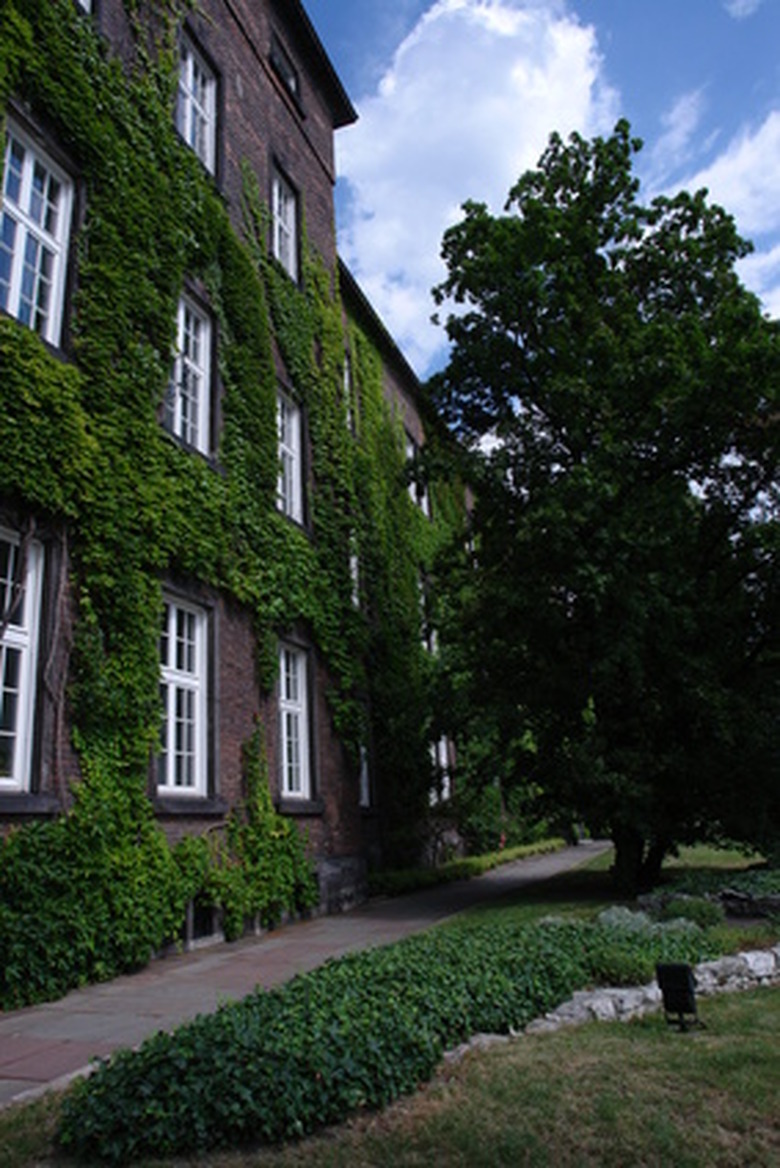The Meaning Of The Ivy Plant
The ivy plant is a perennial vine that grows in a stoloniferous (producing shoots and roots) pattern. Its sticky root extensions attach the vine to other natural or man-made structures, and the plant grows and spreads in a creeping or climbing fashion. Ivy plants are incorporated into landscape designs for their form and deep, bold green color.
Identification
The name "ivy" is from the Old English word "ifig," which may come from the Old High German words "ebahgwi," "ebawi" and "ebah." The term "ivy" is commonly associated with English ivy (Hedera helix), and it identifies a climbing evergreen shrub that has dark green, five-pointed leaves. Ivy is indigenous to Europe, Africa and parts of Asia, according to the Oxford English Dictionary.
The ivy plant symbolized fidelity and eternity in the pagan Celtic traditions and, when they became Christian, they held on to this symbolism and incorporated it into their religious practices. According to "Behind the Name," this is why ivy is often found growing on Christian institutions.
- The ivy plant is a perennial vine that grows in a stoloniferous (producing shoots and roots) pattern.
- The term "ivy" is commonly associated with English ivy (Hedera helix), and it identifies a climbing evergreen shrub that has dark green, five-pointed leaves.
Types
Plants with ivy names belong to different families. The Araliaceae (Ginseng or Ivy) family has more than 700 species of plants, according to the University of Hawai'i at Manoa. These include English ivy (Hedera helix), Algerian ivy (Hedera helix L. ssp. canariensis) and Atlantic ivy (Hedera hibernica). Kenilworth ivy (Cymbalaria muralis) belongs to the Scrophulariaceae, or snapdragon, family; grape ivy (Cissus rhombifolia) belongs to the Vitaceae, or grape, family; and ground ivy (Glechoma hederacea) belongs to the Lamiaceae, or mint, family, according to Texas A&M University.
The Anacardiaceae, or cashew, is in the family of the poison ivy, including eastern poison ivy (Toxicodendron radicans) and western poison ivy (Toxicodendron rydbergii), according to Texas A&M University.
English Ivy
English Ivy (Hedera helix) is a popular ivy used in landscape design. According to the USDA Natural Resources Conservation Service, English ivy grows in a prostate orientation and can grow up to 5 feet long. It is a shade-tolerant plant that has a low tolerance for drought conditions. The USDA states that English ivy can behave as a weed or an invasive plant. In Oregon and Washington, it has this classification.
- Plants with ivy names belong to different families.
- English Ivy (Hedera helix) is a popular ivy used in landscape design.
Uses
Ivy is incorporated into landscape designs as groundcovers and along walls, fences and trellis gardens. When ivy is trained over a fence or trellis, it can grow and spread into a thick mass that adds privacy and shade to an outdoor space.
Diseases
Ivy plants can be affected by several diseases, according to professor D. J. Norman, of the University of Florida. Leaf spot on ivy plants can be caused by Xanthomonas campestris, Colletotrichum trichellum and Phytophthora palmivora. Ivy plants can be susceptible to botrytis blight, a fungal disease caused by Botrytis cinerea, which produces numerous spores in lesions that form on the ivy leaves. Phytophthora palmivora, Rhizoctonia solani and Fusarium can cause root rot diseases in ivy plants.
References
- USDA Natural Resources Conservation Service: Ivy Search Under Common Names
- "The Compact Edition of the Oxford English Dictionary"; Oxford University Press; 1971
- USDA Natural Resources Conservation Service: English Ivy Characteristics
- University of Florida/IFAS: Diseases of English Ivy
